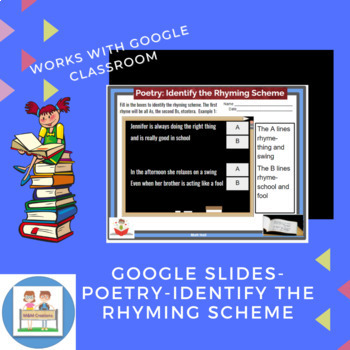Google Slides- Poetry-Identify the Rhyming Scheme
MandM Creations
35 Followers
Grade Levels
3rd - 6th
Subjects
Standards
CCSSRL.4.5
Formats Included
- Google Slides™
- Internet Activities
Pages
37 Google Slides
MandM Creations
35 Followers

Made for Google Drive™
This resource can be used by students on Google Drive or Google Classroom. To access this resource, you’ll need to allow TPT to add it to your Google Drive. See our FAQ and Privacy Policy for more information.
What educators are saying
This is great for rhyme scheme practice...the first five can be completed together and then students complete the remaining slides on their own.
Also included in
- Three Google Slides Documents:1) Identify Rhyming Scheme: Students label the scheme, like AABB or ABCABC.2) Rhyming Scheme- Identify the Missing Word: Students look at the pattern, like ABBA, and identify which word goes in the blank.3) Identify Types of Poetry: Students read poems and identify theiPrice $12.00Original Price $14.00Save $2.00
Description
Students will read through 5 example poems and then practice 16 poems to identify the rhyming schemes. There is a variety of poems with different amounts of stanzas. Some poems are serious and some are silly!
Please contact me at mmedcreations@gmail.com with any questions!
You can print these out or assign them to Google Classroom.
An answer key is provided on slides 22-37.
Total Pages
37 Google Slides
Answer Key
Included
Teaching Duration
N/A
Report this resource to TPT
Reported resources will be reviewed by our team. Report this resource to let us know if this resource violates TPT’s content guidelines.
Standards
to see state-specific standards (only available in the US).
CCSSRL.4.5
Explain major differences between poems, drama, and prose, and refer to the structural elements of poems (e.g., verse, rhythm, meter) and drama (e.g., casts of characters, settings, descriptions, dialogue, stage directions) when writing or speaking about a text.






